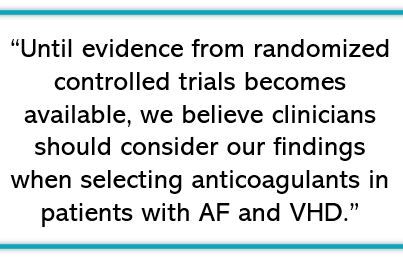- Clinical Technology
- Adult Immunization
- Hepatology
- Pediatric Immunization
- Screening
- Psychiatry
- Allergy
- Women's Health
- Cardiology
- Pediatrics
- Dermatology
- Endocrinology
- Pain Management
- Gastroenterology
- Infectious Disease
- Obesity Medicine
- Rheumatology
- Nephrology
- Neurology
- Pulmonology
Apixaban Found More Effective than Rivaroxaban in Patients with AFib and Valvular Heart Disease
Patients with atrial fibrillation (AF) and valvular heart disease (VHD) treated with the direct oral anticoagulant apixaban had a 43% lower risk of ischemic stroke or systemic embolism and a nearly 50% lower risk for bleeding than those treated with rivaroxaban, according to findings from the first side-by-side comparisons of the 2 factor Xa inhibitors.
Although the 2 agents have been the most frequently prescribed oral anticoagulants for this patient population since 2016, study authors, from the Perelman School of Medicine at the University of Pennsylvania (Penn), say there is limited evidence that directly compares their efficacy in patients with AF and VHD.
“The lack of clinical trial evidence and wide use of both drugs in patients with AF and VHD calls for real-world evidence that can guide treatment selection in clinical practice,” said first study author Ghadeer Dawwas, PhD, a postdoctoral fellow in Biostatistics, Epidemiology, and Informatics at Penn in a something statement. The study findings were published online October 18, 2022, in the Annals of Internal Medicine.
“The lack of clinical trial evidence and wide use of both drugs in patients with AF and VHD calls for real-world evidence that can guide treatment selection in clinical practice."
To emulate a clinical trial of the 2 drugs’ safety and efficacy, Ghadeer and colleagues designed a new-user, active comparator cohort study using commercial health insurance claims data from the Optum Clinformatics Data Mart database from January 1, 2013-December 31, 2020. The researchers identified individuals with diagnoses of AF and VHD who had a first-recorded prescription for apixaban or rivaroxaban during the prescribed period. Patients were required to be at least 18 years of age and have at least 12 months of continuous enrollment in medical and pharmacy benefits prior to cohort entry.
Among exclusion criteria were end-stage renal disease, hip or knee replacement, stroke, systemic embolism, bioprosthetic heart valve replacement, or mechanical heart valve replacement. Individuals with prescriptions for dabigatran, edoxaban, and warfarin and those prescribed dual or triple antithrombotic therapy also were excluded.
The primary efficacy outcome was a composite of ischemic stroke or systemic embolism and for safety, a composite of gastrointestinal or intracranial bleeding.
FINDINGS
From a potential cohort of 58 210 patients, investigators identified 19 894 patients matching their inclusion criteria. The study team calculated propensity scores using logistic regression to match 9947 participants receiving apixaban 1:1 with the same number receiving rivaroxaban. Covariates were well-balanced between the groups, according to the authors.
Incidence rates of the composite safety and efficacy outcomes were calculated as the total number of events per 1000 person-years (PY).
Dawwas et al report the incidence rate of ischemic stroke or systemic embolism per 1000 PY was 5.2 for participants prescribed apixaban and 9.1 for those using rivaroxaban. For GI or intracranial bleeding, the incidence rate per 1000 PY was 14.3 among apixaban-treated patients and 28.1 among rivaroxaban-treated patients.
Following matching, the researchers found that use of apixaban was associated with a lower rate of ischemic stroke or systemic embolism (HR, 0.57 [95% CI, 0.40-0.80]) and for the safety endpoint, a lower rate of GI and intracranial bleeding events (HR, 0.51 [CI, 0.41-0.62]) compared to use of rivaroxaban.

Dawwas and colleagues calculated the absolute reduction in probability of stroke or systemic embolism with apixaban compared to rivaroxaban was 0.0026 within 6 months and 0.011 within 1 year of treatment initiation. Investigators also calculated absolute reductions in probability of 0.012 within 6 months and 0.019 with 1 year of treatment initiation favoring apixaban.
“We emulated a target trial using practice-based claims data and found that patients with AF and VHD who were new users of apixaban had a lower risk for ischemic stroke or systemic embolism and a lower risk for bleeding compared with rivaroxaban,” investigators wrote. “Until evidence from randomized controlled trials become available, we believe clinicians should consider our findings when selecting anticoagulants in patients with AF and VHD.”
Reference: Dawas GK, Cuker A, Barnes, GD, et al. Apixaban versus rivaroxaban in patient with atrial fibrillation and valvular heart disease: a population-based study. Ann Intern Med. Published online October 18, 2022. doi:10.7326/M22-0318
